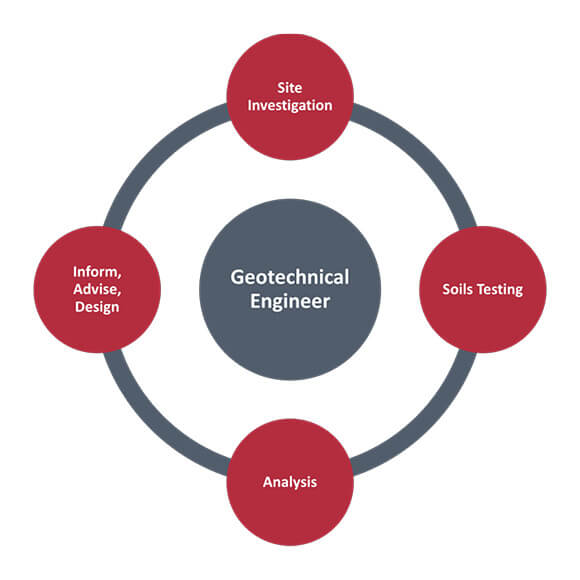Facts About Geotheta Uncovered
Facts About Geotheta Uncovered
Blog Article
What Does Geotheta Mean?
Table of Contents3 Simple Techniques For GeothetaThings about GeothetaThe Best Strategy To Use For GeothetaThe Main Principles Of Geotheta
They team up with civil engineers, architectural designers, architects, and other experts to integrate geotechnical considerations right into the total task layout and construction procedure. This requires efficient synergy, sychronisation, and interaction to ensure that the geotechnical aspects straighten with the task goals and meet regulatory needs.Mining & Products Design: Principles of exploration, infiltration rates, and elements impacting the selection of exploration approach. Characteristics of dynamites, firing systems and blast patterns. Blowing up strategies in surface area and underground functions. Unique blasting methods at excavation perimeters. Vibration and noise control. Mechanical and constant methods to fragmentation, including longwall shearing and fullface boring.
Modelling of fragment and bit dimension distributions; comminution as a transfer feature. Comminution innovation: squashing, grinding, size classification. Integrated evaluation of fragmentation and comminution operations. Supplied by: Mining & Products Engineering.
Everything about Geotheta
Bachelor's level programs in civil, geotechnical, geological, and ecological engineering normally last 4 years and consist of basic education courses in English, social science, and the humanities, along with training courses in innovative mathematics, architectural geology, and fluid mineralogy. (https://medium.com/@ianhammond2191/about)
Geotechnical engineering involves the evaluation of the dirt and rock problems at a particular site, and their effects for the advancement of that site. As the majority of structures depend on the ground for assistance, it lacks shock that a comprehensive understanding of the ground problems, and the suitability of structure systems, are essential to the long-lasting security and efficiency of the structure or structure.
Specialising in the investigation of geological developments and ground behaviour, geotechnical engineers do clinical examinations and screening to recognize the impact these geological formations may have on the style and building and construction of building, civil and infrastructure jobs. This knowledge is essential for the style and building of structures, roadways, passages, dams, bridges, and water and sewer systems.
The geotechnical team at Douglas Partners regularly talk to architects, design designers, programmers, and building contractors to make referrals on layout and growth propositions to make certain that the constructed frameworks are accordingly designed for the ground conditions. As an example, the design of footing systems requires to take into consideration the weight of the framework, the ability of the ground to sustain that weight with each other with movement resistances and reliable construction.
Not known Facts About Geotheta
This job is substantially simplified by the use our Douglas Map geospatial system which makes this details conveniently accessible in a simple to utilize internet internet browser interface. A geotechnical engineer will certainly guide the drilling of boreholes and test pits to accumulate dirt and other examples, and additionally examine surface area functions and ground exposures to create a geotechnical version of the subsurface problems.
Depending upon the project kind and ground conditions encountered, research laboratory screening might among other points analyze toughness, compressibility, reactivity and/or leaks in the structure of soil and rock samples. After this data is accumulated and looked at, the outcomes are used for a geotechnical model of the website, which is generally presented as sections throughout the website.

A geotechnical examination naturally can only evaluate the ground problems at the places drilled or dug deep into. Natural variations in soil and rock conditions can occur across a website and between examination areas. It is consequently excellent practice that the geotechnical engineer be maintained throughout building and construction of the job to provide on-site confirmation that the ground conditions experienced follow the assumptions and guidance supplied in the geotechnical examination record.
Some Known Incorrect Statements About Geotheta
Geotechnical designers use their thorough knowledge of dirt and rock to examine threat and solve problems on diverse framework projectsGeotechnical design is a specialist branch of civil engineering which considers the behavior of earth materials and the application of dirt and rock mechanics. Geo Tech Engineer. As a geotechnical designer, you will certainly examine the physical, mechanical and chemical residential or commercial properties of soil and rock in order to design structures, retaining frameworks and earthworks
Geotechnical design is closely connected to and overlaps with, both design geology and ground engineering - https://triberr.com/geotheta. It's feasible to specialise in geotechnics or benefit a geotechnical company yet be referred to as a design rock hound or a ground designer. As a geotechnical engineer, you'll require to: develop and keep partnerships with clients and other experts involved in the website, throughout each projectmaintain security requirements on website be conscious of cost implications when you make recommendationsstudy geological maps and airborne pictures from a series of sources and from various time periodsexamine building and construction intends to see exactly how feasible they are based upon your understanding of the siteinvestigate threats or geological hazards for the sitesearch for ecologically delicate attributes, such as landfill beginning to develop valid and expository ground modelsplan area investigationsdrill and evaluate samples of bedrock, soil, groundwater and extra products oversee various other experts on sitesolve technological concerns as they occur, such as unexpected frameworks at drill sitesmonitor conditions during and after construction to make certain structures are stable in the short and long termadding information accumulated on site to your first researchcreating geotechnical computations, illustrations, and two or three-dimensional computer designs interpreting the datamaking suggestions regarding the proposed use of the website

Report this page